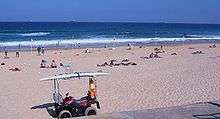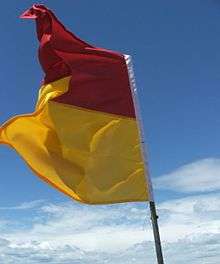Surf lifesaving

Surf lifesaving is a multifaceted movement that comprises key aspects of voluntary lifeguard services and competitive surf sport. Originating in early 20th century Australia, the movement has expanded globally to other countries including New Zealand, Ireland, South Africa, the United Kingdom.[1] Surf lifesavers in Australia are colloquially known as "Clubbies".
History

Surf lifesaving originated in Australia in 1907 in response to drownings at local beaches in Sydney. Such groups became necessary following the relaxing of laws prohibiting daylight bathing on Australian beaches.[2] Volunteer groups of men were trained in life saving methods and patrolled the beaches as lifesavers looking after public safety.
The original surf life saving club is a matter of contention between the Bronte and Bondi beach clubs in Sydney. Bronte Surf Lifesaving Club claims to be the “First Surf Club in the World since 1903”. This is based on minutes of a meeting held in 1907 (found at the local library in 1982), which was noted to be the fourth AGM of the club, as well as a time capsule from 1931 (unearthed during renovations of the club house) in which documents record then President and Gen. Secretary of Surf Lifesaving Australia unanimously declaring Bronte to be the first club. The Bondi Surf Bathers' Life Saving Club also claims to be the “world’s first life saving club”. It was officially established on February 21, 1907 at the Royal Hotel in Bondi - as was recorded in the newspaper The East Sydney Argus, and in the Waverley Council Minutes acknowledging receipt of a letter from the newly formed group.
According to current evidence, it may therefore be correct to say Bronte was the 'first' real club, and Bondi was the 'first official' club. Whatever the original club, it is certain that on October 10, 1907 the Surf Bathing Association of NSW (SBANSW) was founded – with 9 clubs and affiliated associations. The first club outside of Sydney was Kiama Surf Bather's Club, founded in 1908.

The first New Zealand Surf Lifesaving Clubs began in the years 1909-1910 leading of with: Castlecliff (Wanganui), Lyall Bay (Wellington), New Brighton (Christchurch) and Worser Bay (Wellington). Within the next few years other clubs started forming around five regions: Wellington, Christchurch, Dunedin, Gisborne/Napier/New Plymouth and Wanganui.
In the Northern Region, Piha Surf Life Saving Club was founded in 1934, and as such is the oldest club on Auckland's West Coast and is the home of Piha Rescue. Soon after the New Zealand clubs were formed, rivalry began to take place which created the forming of competition between the clubs and regions. By early 1912 competitions were being organised by Wellington's Maranui Club, with male members competing in squads of 8. The competitions consisted of a land drill and 'reel test'. The first New Zealand National Champs where clubs were able to compete was held in 1922.
The Surf Life Saving Great Britain (SLSGB) organisation was formed in 1955. Volunteer clubs patrolled beaches at Bude and St Agnes in Cornwall and Brighton, their aim to protect, rescue and resuscitate bathers.[3] Voluntary organisations exist in Germany, such as DLRG and Wasserwacht.
Rescue services
Lifesavers are volunteers that typically patrol in groups under a patrol captain for a given period of time on weekend and public holidays under a roster system. In order to be a surf lifesaver a person must hold a Bronze Medallion or a Surf Rescue Certificate and pass an annual proficiency test. Life savers who are on patrol wear red and yellow cloth caps on the head. While not performing rescues they are also required to wear long-sleeve yellow shirts and red shorts to provide protection against the sun. Support Operations Lifesavers are required to wear the appropriate functional attire. This includes wetsuits for RWC (Rescue Water Craft) drivers, JRB/ORB (jet and offshore rescue boat) crew and high visibility tabards for Duty Officers who liaise with other emergency services at major incidents. The crews of various Lifesaver helicopter services over the country wear appropriate aviation equipment. Each surf life saving club also has a competition cap with distinct colours or patterns. These are worn during competition and for training on the beach. The patrolled area of the beach is marked out with flags and beachgoers are encouraged to swim between the flags. Those wishing to use surfcraft are required to remain outside the flags.
In the UK, SLSGB has a long history of voluntary members patrolling local beaches, offering advice, first aid and rescue services. This continues today and is a vital service to the community. Many local authorities provide a lifeguard service from May to September on popular beaches. In some areas Royal National Lifeboat Institution(RNLI) Lifeguards operate on behalf of the local authority.
Competition
The other key part of surf life saving is the competitive sport which evolved from the training activities of lifesavers at Australian and New Zealand surf beaches, though most events share little with modern Inflatable Rescue Boat (IRB) based surf rescue techniques. The sport is still based on the volunteer clubs which perform the rescue duty, from the children in the "nippers" through to professional elite circuits that have been established for the high-profile "ironman" events. The sport is mainly still confined to Australia and New Zealand, although the Nova Scotia Lifeguard Service in Canada has run the Nova Scotia Surf League competitions every summer since 2000, and competition programs exist in 5 regions of Canada. In Europe the sport is increasingly developed, with Italy, Spain and Germany particularly strong and the UK, the Netherlands and Ireland developing rapidly.
Surf life saving clubs regularly hold surf carnivals where clubs compete with each other in a range of beach- and rescue-oriented events including combined swimming and running, surf ski and surf boat races. The youth arm of the clubs is known as Nippers, and holds similar events.
The various events involve elements of surf swimming, board riding, sand running, mock rescues using rowed surf boats, and paddling special kayak-like surf skis. Some events are for individuals, but many are team events.
Individual surf lifesaving events include:
- Ironman
- Long boat rescue (also called surf boat rescue)
- R&R (Rescue & Resuscitation)
- March Past
- Beach events (including Beach Sprints, Beach Relays and Flags)
- Surf Ski
- First Aid Competition, Champion Lifesaver and Patrol Competition
- Board events
- IRB racing
Individual surf life saving clubs compete at the state and national levels at the annual State Championships and Australian Surf Life Saving Championships.
Life saving today

Surf lifesaving in Australia is well-developed as both a voluntary lifesaver service and as a competitive sport. There are 305 surf lifesaving clubs in Australia that collectively patrol over 400 beaches. In the 2003-2004 season there were 24,968 active members (those who are rostered to patrol regularly), of which approximately 40% are women. In the 2003-2004 patrol season, lifesavers performed 9,044 rescues, provided emergency care to 26,739 patients, and undertook 171,965 preventive actions.
Surf Life Savers provide important surf rescue services on beaches in Australia on weekends and public holidays throughout the patrol season on a volunteer basis. In New South Wales the season coincides with the beginning of the September school holidays and finishes on ANZAC Day. They also provide year-round on-call volunteer rescue services in most areas known as Support Services.
Life savers are distinguished in Australia from paid lifeguards which are generally employed by the relevant Local Government authority and patrol the beach throughout the year. Lifeguards also patrol lakes, pools, and other aquatic venues. Support Services also operate to augment the patrols on the beach by providing surveillance away from the flag areas and emergency back-up when required.
See also
- Commonwealth Pool Lifesaving Championships
- International Life Saving Federation
- Royal Life Saving Society Australia
- Surf Life Saving New Zealand
- The Coolangatta Gold
- United States Life-Saving Service
References
- ↑ Derek Farrar. "The Goto Guy". Hana Hou! Vol. 9, No. 6 (Dec 2006 / Jan 2007). photos by Dana Edmunds.
[T]he City and County of Honolulu’s Ocean Safety & Lifeguard Services Division … pioneered lifesaving technology now emulated around the world, most notably the development of jet ski surf rescues in the early 1990s.
- ↑ "Surf Life Saving - Stories from Australia's Culture and Recreation Portal". [Online], Commonwealth Government of Australia, 2006.
- ↑ "Surf Life Saving Great Britain-History". Retrieved 30 September 2010
Further reading
- David Eaton (1995). Lifesaving: Handbook of The Royal Life Saving Society United Kingdom. RLSS UK. ISBN 0-907082-59-9.
